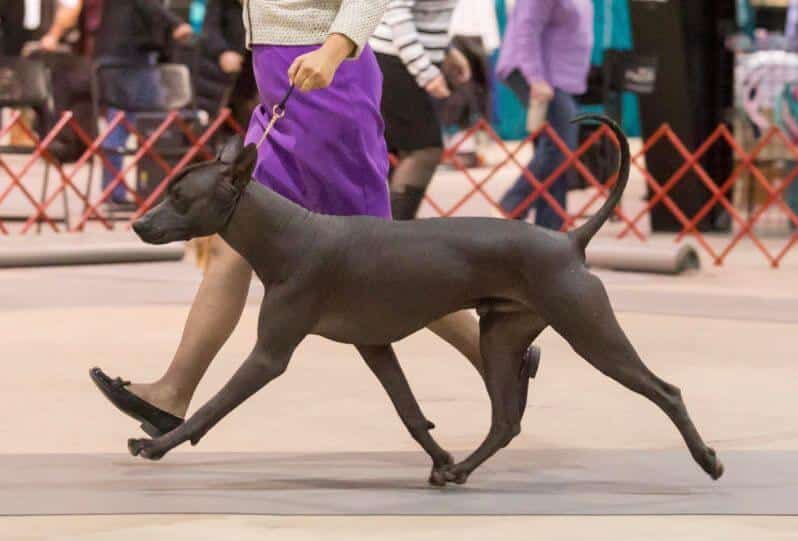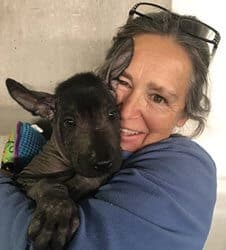Interview with Non-Sporting Group Breeder Teresa M Vilá
Where do I live? How many years in dogs? How many years as a breeder?
Teresa M Vilá: My husband, Kevin Crosby, and I are currently living in Louisburg, North Carolina, after making a move from Colorado at the end of 2021. We moved in order to be closer to my mother. I began in the sport of purebred dogs, exhibiting and breeding Dalmatians with my family in the early 1970s to ‘80 when I left for college. Fast forward 20 years and I started back in dogs doing rally obedience with my first two Xoloitzcuintlis and helping others in the conformation show ring with their dogs. This motivated me to return to the conformation ring while also wanting to learn as much as I could about Xolos and their pedigrees. In 2012, we brought home our first conformation Xolo, GCHS Besitos Muñequita, from the world-renowned breeder Patty Hoover of Besito Xolos in Washington State.
What is my kennel name? How many dogs do I currently keep?
Teresa M Vilá: Our kennel name is Ahuilaca, which means “playful and mischievous” in the Nahuatl language. We felt that with this one word, Ahuilaca describes the personality of the Xolo very well. We currently have three Xolos. Since we are still settling in to a new state and home, that number will remain low. We feel a good number for us is no more than six adult dogs, ensuring that each gets a good amount of individualized attention.
Which show dogs from the past have been my noteworthy winners?
Teresa M Vilá: My most noteworthy winner is GCHS Besitos Muñequita. “Muñe” was my first conformation Xolo and we had a great time in the ring, achieving so much with limited showing and always owner-handled. Some of the highlights with Muñe in the show ring were her multiple Group Wins and many Group Placements. Those memorable wins included a Group First during the XCA National weekend in Alamogordo, New Mexico, BOS at Westminster, and BOB in a large and beautiful lineup during the AKC National Championship pre-shows in Orlando. Today, I have a very promising young male, GCH Zacahuil Del Rey, who has achieved a great deal of recognition in the show ring so early in his career. “Zaca” is currently #1 Owner-Handled Xoloitzcuintli. He has a NOHS RBIS, half a dozen NOHS Group Firsts, and several NOHS Group Placements.
Which have been my most influential sires and dams?
Teresa M Vilá: GCHS Besitos Muñequita produced four champions in her one and only litter. Three went on to get their GCH, and one continued on to get her GCHB. Unfortunately, due to complications, Muñe was not able to be bred again. She was awarded Best Brood Bitch at the Xoloitzcuintli Club of America National Specialty in 2018 and 2019. Her daughter, GCHB Ahuilaca Etla, took the same honor at the 2021 XCA National Specialty. GCH Zacahuil Del Rey holds a lot of promise should he produce like his prolific sire, SE FI DK NORD CH & US GCH El Huasteco (Arena) SOD. “Zaca” will bring a lot to our future breeding program and to the breed.
Can I talk a bit about my facilities? Where are my puppies whelped? How are they raised?
Teresa M Vilá: Our dogs are raised in our home, underfoot, and are part of our household. In Colorado, our litters were born and raised at our bed and breakfast. Prior to breeding, I prepared myself with a breeding library; my favorite being the Myra Savant Harris Reproduction, Whelping and Puppy Intensive Care books. Later, I was fortunate to attend Myra’s seminar where I met an amazing theriogenologist, Dr. Brittany Shumack, DVM, who was fantastic to work with. I am very hands-on with the puppies and devote myself completely to their first 3-4 weeks of life. After the first puppy breaches the whelping box, the litter is transitioned to a large x-pen in the middle of our household’s daily activity. Working from home made it possible to provide lots of enrichment for the puppies. We follow Puppy Culture, introducing puppies to a variety of new situations through sounds, smells, visitors, and novel experiences that all shape the foundation to their socialization. With our last litter, we took the puppies through the Volhard Puppy Aptitude Test at 7 weeks to get a better sense of the areas where they individually needed more exposure with enrichment games to build better confidence.
What is my “process” for selecting show puppies? At what age do I make my decisions?
Teresa M Vilá: We take weekly photos of every puppy from birth until they go to their new homes. When the puppies are 4 weeks old, the first stacked photos are taken. The puppies we keep continue with photo shoots to document their development. Our selections for show potential puppies happens between 7-10 weeks of age. We spend a lot of time just watching them interact and move about, making selections based on traits we were hoping to improve or capture with the breeding pair.
How do I prepare my pups for the show ring? Does my breed require any special preparation?
Teresa M Vilá: We do a lot of casual training at a young age. By keeping sessions short but numerous, the puppies build on their skills. When they are 3-4 months old they begin conformation classes, which helps transition them to the show ring. Xolos are a “primitive” breed and require proper and
consistent socialization.
Can I share my thoughts on how my breed is currently presented in the show ring?
Teresa M Vilá: I feel breeders and handlers are presenting the Xolo true to its nature without too much fuss, and are often using a free-stack to showcase their silhouette. When standing, their tail should be left in a natural position, which is often down and relaxed. When alert and moving, they naturally carry their tail up but never to touch the back. Expression is important, and this is also presented well in the ring.
Are there any health-related concerns within my breed? Any special nutritional needs?
Teresa M Vilá: The OFA database in Xolos is growing steadily as more breeders are submitting test results and obtaining CHIC numbers. In addition to the recommended parent club health tests, many breeders go above and beyond with additional tests through OFA and other screening sources, such as PENN Hips. Advancements in technology in DNA testing from companies such as Embark and Optimal Selection are also used in collaborative documentation. While the Xolo numbers are still low in these DNA databases, they are increasing, adding a much-needed reference point. At this time, there are no breed-specific tests for Xolos, but these types of screenings can identify carriers of health conditions such as Degenerative Myelopathy (DM) and PRA (Progressive Retinal Atrophy), for example, which provides invaluable information when making breeding selections. Unfortunately, there are many health conditions, such as autoimmune conditions (i.e., Addison’s, IMTP, IMHA, EPI, SRMA) that do not have markers and have popped up in Xolos as they do in many other breeds. I have heard of some issues with various kidney conditions as well as cancers. Xolos are susceptible to health issues just like any breed. Diet for the Xolo does not require any special nutritional needs beyond a quality food that can be enhanced with raw food, but this is not necessary. While the Xolo can have adolescent acne, it generally clears up as adults. Chronic skin issues may require a specialized diet and guidance from a board-certified dermatologist. These conditions may be individual but also genetic, and could be immune-related.
In my opinion, is my breed in good condition overall. Any trends that warrant concern?
Teresa M Vilá: I do feel that my breed is in good condition overall, as the serious breeders have the best interests of the Xolo at heart. Not only do they want to produce a sound Xolo with good temperament for the show ring, but also for the many families that hope to add a Xolo to their lives. Having grown up in dogs and as an artist, the first thing I look at is the outline for breed type. I had a judge tell me years ago that breeders needed to pay attention to the tail carriage, as she was seeing more and more curled tails. I am now seeing this trend around the world and at the highest levels of competition, making it appear that there is a possibility of it becoming the norm—which is incorrect.
Is my breed well-suited to be a family dog? Who are the best candidates to own my breed?
Teresa M Vilá: The Xolo is well-suited to be a family dog with the committed owner. The Xolo needs a lot of proper socialization which requires time, understanding, and patience. Expanding on the foundation set by the breeder, a family needs to be prepared to do some basic obedience that should continue and remain constant throughout the life of the dog. This regiment and line of communication is required to establish boundaries so that they become a great family dog. While they are an athletic and high-energy breed, they love their down time to cuddle. Xolos are very bonded with their families but also with extended members and friends who become part of their social pack.
Do I feel that my breed is supported by a sufficient number of preservation breeders?
Teresa M Vilá: The Xolo, being relatively new to AKC, has low numbers in comparison to other breeds. However, we have a number of wonderful breeders across the US who are dedicated to the Xolo and have mentored others who have shown an interest, therefore those numbers are sure to grow. Also, several AKC breeders work with breeders in Mexico and around the world, bringing in much-needed genetic diversity.
For a bit of fun, what’s the most amusing thing I’ve ever experienced with my Non-Sporting Dog?
Teresa M Vilá: Our second Xolo was quite the character; very low key, sensitive, and extremely observant. “Machu” was a sharp and eager learner who was the first Xolo to get a Rally Advanced Excellent (RAE) title in AKC. On our first road trip with our travel trailer, we had been driving across Colorado and Wyoming for a ridiculous number of hours. When we finally pulled into Little America, Wyoming, for the night, he was clearly tired and ready to get out for a potty break and stretch his legs. Thinking that we were going to load up and drive off again, he was just shuffling along with our other Xolo, lacking any animation. I will never forget the look of pure joy on his face and the transformation that took over his whole body when I opened the door to the trailer to let them in. He looked at me with wonderment in his eyes as if asking, “Wow, how did this get here? We are home!” I spent time in the trailer with them to prepare for the trip, and they loved it. “Sombra” just pushed through to get on the bed, but Machu was all wide-eyed, oozing pure happiness. Looking straight at me, I could see his comprehension travel through his whole body. It’s really hard to explain, but I will never forget his reaction. Machu lived to be 16. He’s been gone for a few years, but he left us with such great memories.
I feel breeders and handlers are presenting the Xolo true to its nature without too much fuss, and are often using a free-stack to showcase their silhouette. When standing, their tail should be left in a natural position, which is often down and relaxed. When alert and moving, they naturally carry their tail up but never to touch the back. Expression is important, and this is also presented well in the ring.









